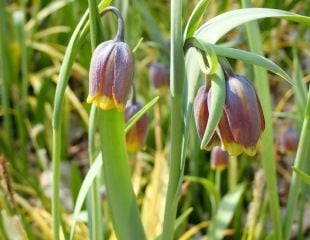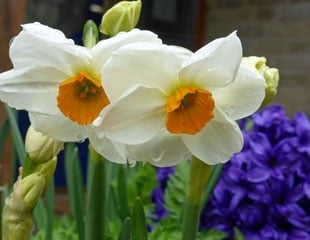
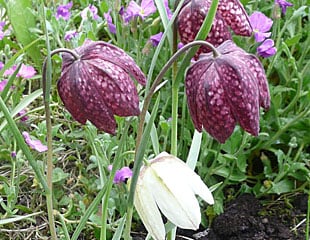
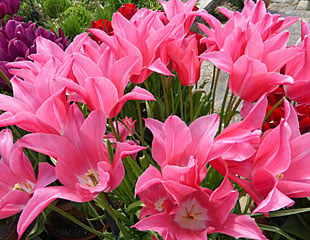
Spring Flowering Bulbs
Besides the popular favourites such as Narcissus (daffodil) and Tulipa (tulip), there are many more spring-flowering bulbs to explore. I enjoy planting Crocus, Hyacinth, Galanthus (snowdrop), Cyclamen, fritillaria, Iris, Muscari, and Scilla — each bringing its own colour and charm to the garden. Images of some of these bulbs are shown below.
Top tip before you buy bulbs: When selecting spring bulbs at the garden centre, choose those that are firm and of a good size, just like picking onions at the supermarket. Avoid any that feel soft. And don’t forget — old compost can be reused for new bulbs, saving money and giving them a nutrient boost- check out my money-saving guide to using old compost.
Planting: When planting bulbs for a spring display, it's usual to plant in September, although Hyacinths and Tulips are usually planted a little later, in October or November. Planting at the correct depth is key to healthy flowering and bulbs returning year after year. Check the table below for the recommended planting depth for each type.
Many Tulips are best treated as annuals, but there are a few perennial varieties- A guide to Perennial Tulips. When planning a display, consider flowering times: snowdrops bloom early, tulips later, and both daffodils and tulips have early, mid-season, and late varieties. Choosing the right types ensures your colours and combinations bloom together perfectly.
Top Tip: Squirrels like bulbs protection with chicken wire to keep bulbs safe.
Top Tip: It is essential to plant spring bulbs at the right depth to ensure they flower — see my easy-to-use planting depth table
Both Crocus and Suttons have excellent ranges of bulbs, at great discounts.
Planting spring bulbs- Dont forget about Squirrels
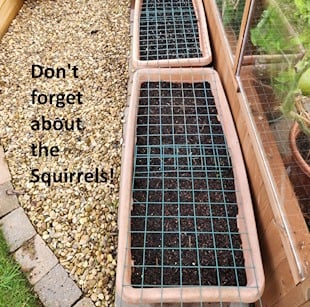
Whatever type of spring bulbs you are planting, don't forget about the squirrels. They love bulbs, and will dig them up and squirrel them away for winter feed.
The only way to prevent this is with a physical barrier as in the image.
One year, I planted 50+ tulips in a wall alongside a pond, only to find that only a handful survived the squirrel raid.
Different types of Spring Flowering Bulbs
Camassia
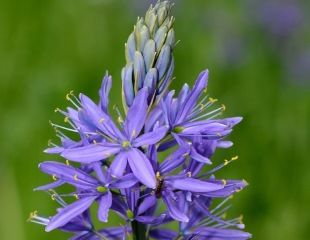
Camassia is a less commonly grown spring bulb which puts on a fabulous display.
Key Facts:
Height: 30-90cms
Soil: Any, preferably moist but not waterlogged
Light: Full sun/part shade
Special Features: Attractive blue, violet or white spires of flowers, good to plant instead of bluebells. Easy to grow, not so invasive.
Link to the full growing guide and images of Camassia.
Muscaria
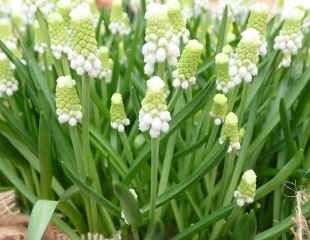
Muscaria, the Grape hyacinth, a small bulb which returns reliably every year.
Key Facts:
Height: up to 20 cms.
Soil: Moist but well drained
Light: Sun or partial shade
Special Features: If the blue variety is too ubiquitous, there are now many other coloured varieties. Illustrated is Muscari aucheri 'White Magic' Will naturalise.
Narcissus
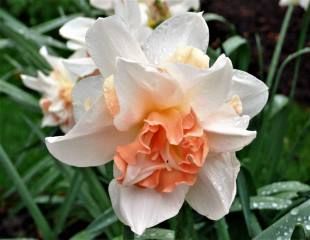
There are some 25,000 registered narcissus cultivars with around 1,500 -2000 available to buy, and that's plenty to choose from.
Key Facts:
Height: 20-50cms, depending on cultivar
Soil: Any
Light: best in full sun
Special Features: a wide range of flower types, shapes and many are scented. Daffodils are uniquely sensitive to planting depth in order to flower every year.
Full guide to planting daffodils, planting depths and what to do if they do not flower.
Fritillaria
Fritillaria popular varieties are F.meleagris, F.imperialis and F.michailovskyi, all impressive spring bulbs
Key Facts:
Height:35 cms meleagris, 1.2m imperialis
Soil: most soils, moist well well-drained
Light: meleagris sun or partial shade imperialis full sun
Special Features: F. meleagris will naturalise, is essentially a woodland plant, whereas f. imperialis is more suited to a border in full sun.
Erythronium

Erythronium, an unusual spring bulb, with delicate, small flowers also known as dogtooth violet shown naturalised on a grassy bank.
Key Facts:
Height: 15 cms
Soil: any, well drained
Light: full sun to partial shade
Special Features: looks best naturalised in woodland setting.
Hyacinth

Hyacinths have highly scented flowers which will return the following year. The only maintenance is a little staking to support the flower heads.
Key Facts:
Height: 25cms
Soil: Moist, well-drained
Light: Full sun /light shade
Special Features:The flowers are highly perfumed and shades of pink, red, white, blues, yellow and orange
Snowdrops
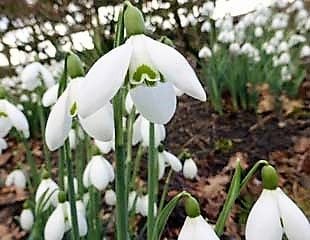
A garden favourite, Snowdrops are the earliest of the spring-flowering bulbs, bringing cheer to the garden.
Key Facts:
Height: up to 30 cm
Soil: moist well drained, add leaf mould to combat dryness
Light: best in partial shade, avoid hot, dry areas
Special Features: There are now many showy and larger varieties of Snowdrops. They can be difficult to establish, particularly in dry conditions.
Complete growing guide for Snowdrops with tips on how to get them established and planting "in the green".
Bluebells
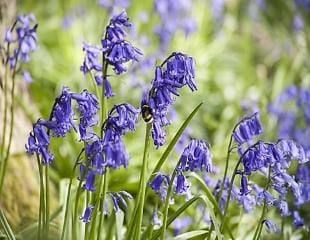
Bluebells Hyacinthoides non-scripta, are the English bluebell. They look good planted in a group, in a woodland-type setting.
Key Facts:
Height: 40cms
Soil: any, moist, well-drained
Light: full sun or partial shade
Special Features: easy to establish, can be invasive and plant with care.
Cyclamen coum

Cyclamen coum is a late winter and early spring flowering variety of Cyclamen.
Key Facts:
Height: 10cm
Soil: any
Light: light shade
Special Features: This is the winter and spring flowering Cyclamen which looks good naturalised around base of trees/woodland type setting


